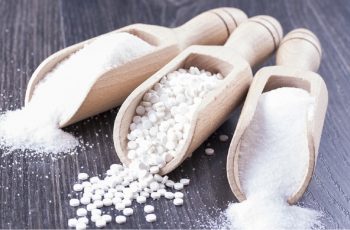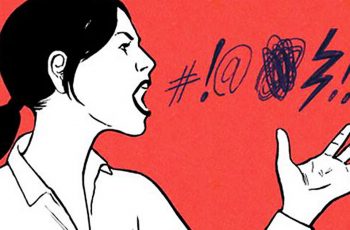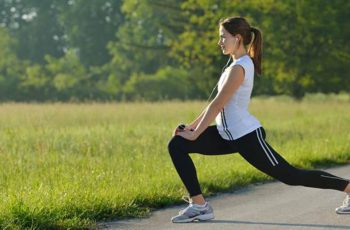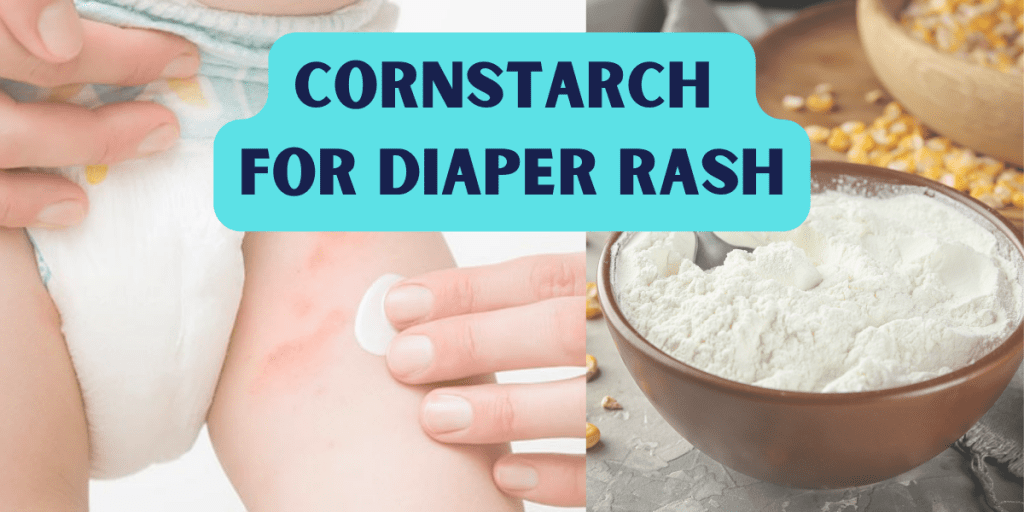
Cornstarch is often recommended as a home remedy for diaper rash. But is it safe to use? What are the potential risks? This post will explore the pros and cons of using cornstarch to treat this common skin condition. By the end, you’ll better understand whether or not this home remedy is suitable for your little one’s sensitive skin.
What causes diaper rashes?
- Wet or soiled diapers: If diapers are not changed frequently enough, the skin can become irritated and inflamed.
- Rubbing and chafing: Diapers that are too tight or rubbing against the skin can irritate.
- Allergies: Some babies are allergic to materials such as latex or synthetic fibers. Others may be sensitive to specific ingredients in diapers, baby wipes, or soaps.
- Infections: Diaper rash can sometimes signify a fungal or bacterial infection.
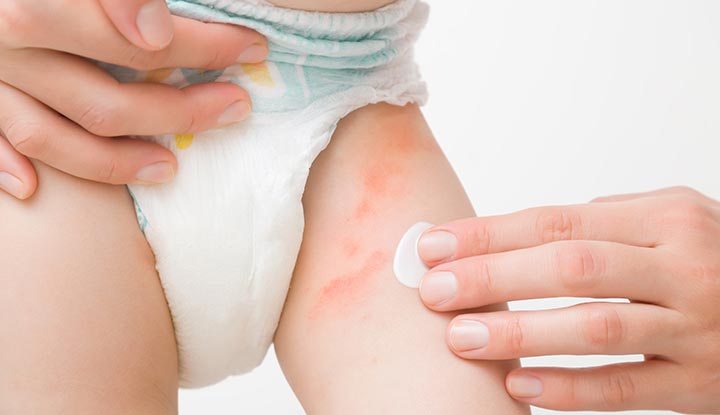
Cornstarch Baby Powder VS Regular Baby Powder: Why Cornstarch is Better
Pros of Cornstarch Baby Powder for Diaper Rash
- Cornstarch baby powder is a natural substance that is gentle on the skin and helps absorb moisture, keeping the skin dry and helping to prevent chafing.
- Cornstarch also has anti-inflammatory properties that can help to soothe irritated skin.
- Cornstarch is an inexpensive and widely available product, making it an excellent option for parents on a budget.
- Cornstarch baby powder can be applied directly to the little one’s diaper area or sprinkled into diapers before putting them on.
- Cornstarch Baby Powder can be a great way to soothe and protect your baby’s bottom from diaper rash. Apply cornstarch to the affected area and allow it to sit for 15-20 minutes before wiping it away. For best results, cornstarch should be used after each diaper change.
- Cornstarch Baby Powder is hypoallergenic and free of fragrances, dyes, and other harsh chemicals, making it an ideal choice for sensitive skin.

Diaper rashes can be treated with cornstarch in a variety of ways, where you’re creating more natural remedies, including:
- Cornstarch can act as talcum powder on your baby’s skin. Pour some warm water over a clean cloth and wring out the excess. Clean your baby’s bottom by squeezing the excess moisture out of the fabric. Allow 2-3 tablespoons of cornstarch to slowly be sprinkled onto your baby’s skin after it has dried. After waiting for five minutes, it’s time to change the diaper on your baby. This method can be used a couple of times a day, up to three times.
- Cornstarch and petroleum jelly can be mixed to make a paste that can be used as a thickener. Make a thick cream out of it by thoroughly mixing everything. The affected area should be treated with cream. After 10 to 15 minutes, use a warm, wet cloth to remove the cream. This mixture can be used up to twice a day.
- Cornstarch can also be combined with coconut oil and vitamin E for another recipe. Cornstarch, coconut oil, and a vitamin E cap are all needed to make a paste. After applying the paste to the affected area, keep it there for ten minutes. Finally, rinse the area with warm water and allow the skin to dry before putting on a new diaper.
Is cornstarch or baking soda good for diaper rash?
Combine cornstarch with coconut or olive oil to form a barrier on your little one’s skin. However, keep it away from your baby’s face and airways since it might impair breathing if breathed. Instead, use apple cider vinegar in the same way you would baking soda by putting some in your child’s bathwater.
Can you mix cornstarch and Desitin?
Mix cornstarch and Desitin until very thick. None of the other recipes we attempted from the doctor worked as well as this one. We utilized liners or disposables for a short period, but it is not safe for cloth diapering.
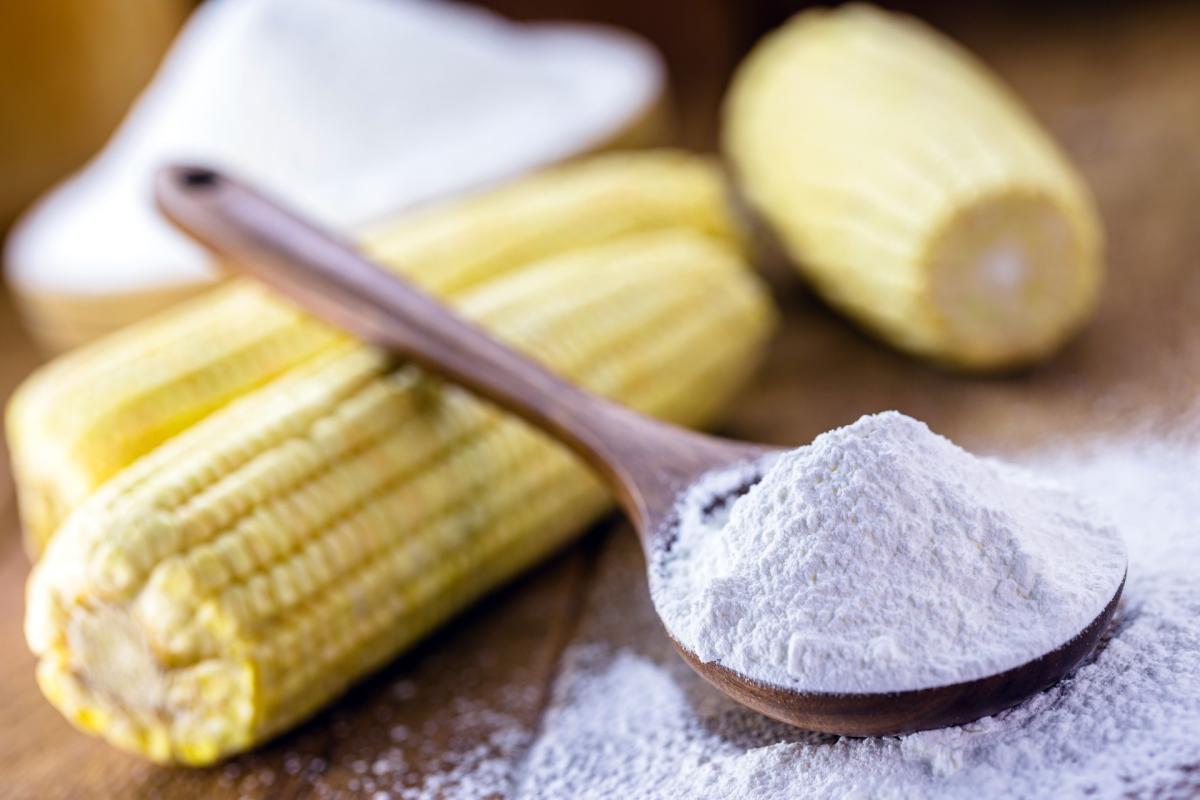
Cons
Cornstarch, like baby powder, helps to dry out the skin and offers some slides to lessen the chance of chafing. However, cornstarch also disperses in the air and, if breathed, may irritate a child’s lungs. So be very careful during diaper changes.
Many online articles claim that cornstarch can worsen diaper rash and yeast infections. However, this is not true. Doctors are most likely to recommend treatment with zinc oxide for yeast-related diaper rash. However, we will not advise you to use zinc oxide unless you have a prescription from your doctor. If you suspect a yeast infection in your child, immediately make an appointment with a pediatrician.
Pros of Regular Baby Powder for Diaper Rash
- It can help absorb moisture from the skin, reducing irritation and inflammation and preventing diaper rash.
- It can help to soothe and calm the skin. It helps keep the skin dry, speeding up the healing process.
- It has a soothing effect on the skin, relieving the itching and irritation associated with diaper rash.
- It is inexpensive and easy to find, making it an accessible option for many families.
- It can provide a barrier between the skin and wetness or stool, further reducing irritation.
- Regular baby powder can be used with other diaper rash treatments, such as creams or ointments. When used correctly, it can help to provide complete relief from this pesky problem and help prevent atopic dermatitis.
Cons
- It can be drying to the skin and may make the rash worse.
- It can be messy and cause a dust cloud when applied.
- Inhaling baby powder can be harmful, particularly for infants.
- Removing from the skin, clothing, and bedding can be challenging.
- It can be messy and difficult to apply.
- If inhaled, it can cause severe respiratory problems.
- It can also be dangerous if accidentally ingested.
- Regular baby powder should never be used on open wounds or inflamed skin.
- Most baby powders contain talc, which has been linked to cancer.
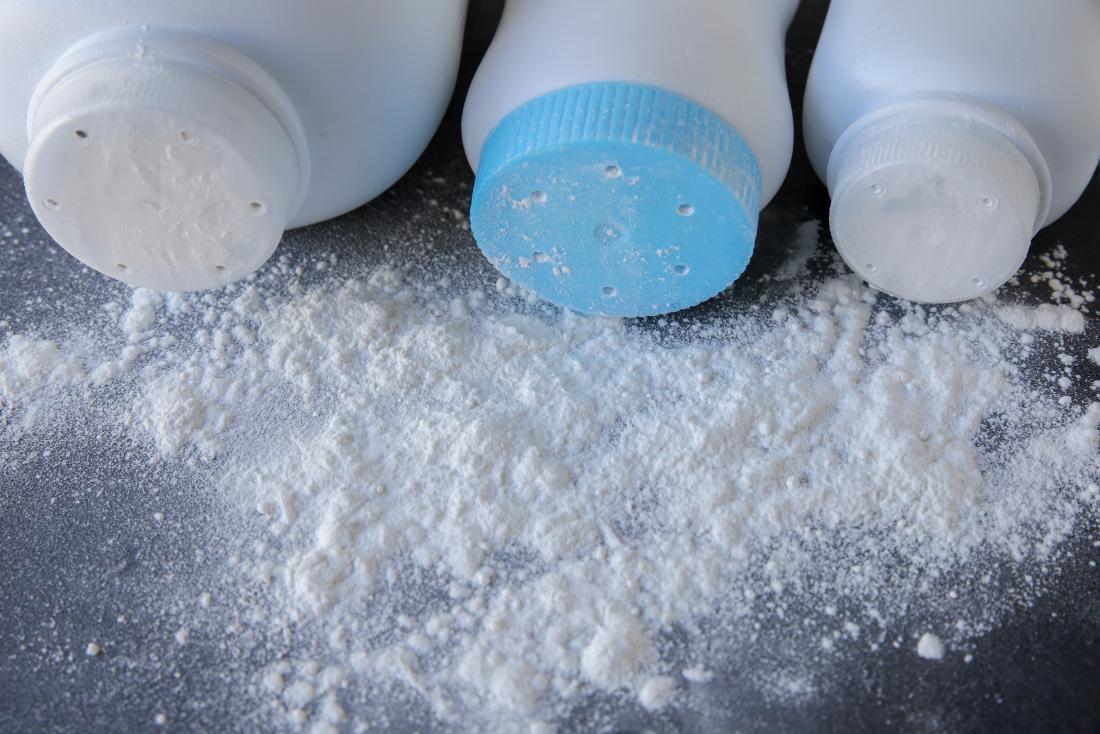
Dangers of Talcum Powder Present in Baby Powder
Talcum powder is a component of conventional baby powders. Talc, a mineral consisting of magnesium, silicon, and oxygen, is the basis for talcum powder. Since many talc mines are situated in regions where asbestos naturally exists, some talc does contain asbestos.
Research has connected asbestos to ovarian and lung cancer. Talc inhalation may also irritate the respiratory system and lungs. Talcum powder is especially hazardous for a child’s diaper region since a baby’s lungs are significantly more vulnerable to irritation. This is why a lot of parents prefer more natural treatments.
Particles in the air may get into their nose and mouth, even when used cautiously. Johnson & Johnson has been the target of several lawsuits regarding the connection between their baby powder, cancer, and other adverse effects.

Is cornstarch a safer alternative to baby powder?
Yes, cornstarch is a safer alternative to regular baby powder. There are five reasons cornstarch is so fantastic alternative to baby powder for rashes. Let’s take a look at each one:
- Creates a barrier: Cornstarch is not soluble in water (or with an acid like vinegar, which is more acidic than urine), so it makes an excellent barrier between the skin and the diaper after the baby wets, protecting the delicate skin from exposure to urine.
- PH neutral: Cornstarch is PH neutral, so it’s very gentle on healthy skin.
- Reduces friction: Cornstarch has a silky, delicate texture that naturally reduces friction between the skin and the surface of the diaper in the same way as talc baby powder.
- Drying: Though it’s not water soluble, cornstarch will “suspend” itself with water, so when put on a baby’s skin, it will dry the skin, which is excellent for diaper rash, and create a smooth barrier around it at the same time. Rubbing some into your skin (after a shower or washing your hands) is the best way to experience and understand these strange and opposite effects. When you reduce moisture, there is less chance of diaper rash and chafing. Meaning no red bumps or allergic reactions.
- Natural: While it still undergoes some processing, it’s worth noting that corn flour is a well-known pantry staple on the same level as coconut oil and vinegar. As most moms will agree, there’s something to be said for using pantry-safe items over commercially mixed and packaged lotions and balms, no matter how much green ink the packaging uses.
Combining these characteristics, cornstarch is a gentle and natural way to add a nice barrier to your baby’s skin, keeping wetness away and reducing friction, just like many commercial barrier or steroid creams promise. This makes it very good at calming moisture-related diaper rashes and preventing new ones from happening. Plus it is more natural than talc based baby powder, meaning you’re not putting unnecessary chemicals into your baby’s diapers.
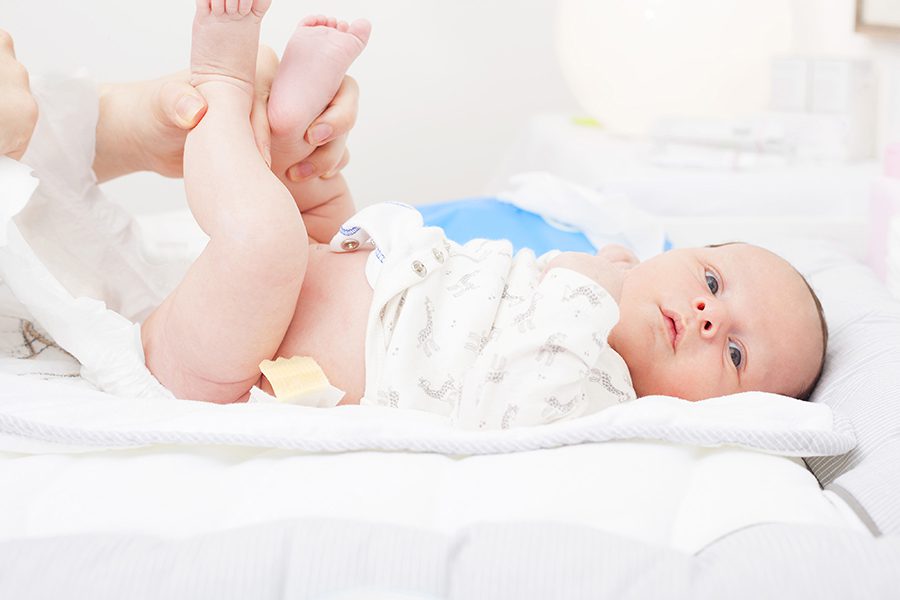
How Do You Use Cornstarch For Diaper Rash?
- After placing it in your palm, the best course is to apply the cornstarch to the diaper region directly.
- Instead of using a bottle like one for baby powder, put it in a tiny container with a spoon or other tool to scoop it into your hand.
- When there isn’t a rash present, use cornstarch on its own after each diaper change. Do it while using cloth diapers, as it can make a massive difference in the quantity and frequency of rashes, bringing them down to almost none.
- Remember that cornstarch isn’t water-soluble, so if your baby has or develops a rash, use cloth-safe diaper cream on top of it to help it remain on your baby and somewhat dry up the area.

Will Cornstarch Activate A Diaper Rash Caused By Yeast?
Many websites assert that cornstarch will worsen a yeast infection. Cornstarch won’t worsen a yeast infection, despite that it’s a basic starch.
According to a 1984 study by JJ. Leyden, “The growth of Candida albicans experimentally inoculated onto the skin of human volunteers, was not enhanced by the addition of either cornstarch powder or talcum powder. Sufficient nutrients for the growth of C. Albicans exist on human skin, provided sufficient moisture is present. Furthermore, cornstarch and talc powders were shown to minimize frictional injury experimentally induced in human volunteers. These studies indicate that cornstarch and talc powders do not enhance the growth of yeasts on human skin and provide protection against frictional injury.”
This research found that cornstarch didn’t worsen yeast development. Instead, it might assist prevent friction-induced skin damage on the affected area (remembering that yeast-infected skin is usually red and sore). It will actually lessen contact dermatitis rather than worsen rashes caused by other powders. Add cornstarch powder to disposable diapers and you are likely to notice a major positive change in your baby’s skin, plus see any previous rashes have completely healed. Severe diaper rash can be a thing of the past! Which means more comfort for your baby and more peace for you in return.

Final Thoughts
Overall, cornstarch is a gentle and natural way to add a barrier to your baby’s skin, keeping wetness away and reducing friction. This makes it very good at calming moisture-related diaper rashes and preventing new ones from happening.
However, it is essential to remember that cornstarch is not water-soluble, so if your baby has or develops a rash, you should use cloth-safe diaper cream on top of it to help it remain on your baby and somewhat dry up the area. Additionally, while cornstarch will not worsen a yeast infection, talk to your pediatrician if you have any concerns about using cornstarch or if your baby’s diaper rash does not improve with home treatment.
FAQs (Frequently Asked Questions)
Will cornstarch help a rash?
Cornstarch for Rash and Irritation of the Skin
Cornstarch’s high zinc level aids in reducing itching and irritation brought on by rashes. In addition, its naturally relaxing properties help to calm the skin and reduce swelling, redness, and inflammation brought on by rashes.
What cures diaper rash fast?
The best way to prevent diaper rash on your infant is to keep their skin as dry and clean as possible. Use a baby wipe to clear baby’s stool from the area, then suit them up in a clean diaper – disposable diapers are often preferable to cloth diapers, since they can be tossed easily and are more sterile out of the package.
Your healthcare practitioner may advise if the rash doesn’t clear after using home remedies: a mild soap or baking soda bath, air dry time and then fresh disposable diapers. Use a little hydrocortisone (steroid) cream twice daily for three to five days. If your infant develops a fungal infection, use an antifungal cream.
Does cornstarch feed yeast infection?
Many people think that yeast will consume cornstarch. This is because the primary component of many infant powders is cornstarch. Researchers looked at this as part of an older study from 1984 but discovered no connection between using cornstarch and more yeast growth.
How do you make corn starch butt paste?
Stir in 3/4 cup of cornstarch until well combined. Your baby’s bottom is kept dry with cornstarch, a natural (and far safer) alternative to talcum powder. Then, keep it in an airtight container for up to a month. This concoction can help soothe sensitive baby skin and keep baby’s rash at bay.
Is cornstarch good for itchy skin?
Although no evidence supports its effectiveness for this usage, cornstarch may be a practical and affordable treatment for skin irritation. Nevertheless, many people employ it to lessen skin itching and soothe sunburns. Cornstarch and a few drops of water should be combined in a dish to create a paste about the consistency of peanut butter.

